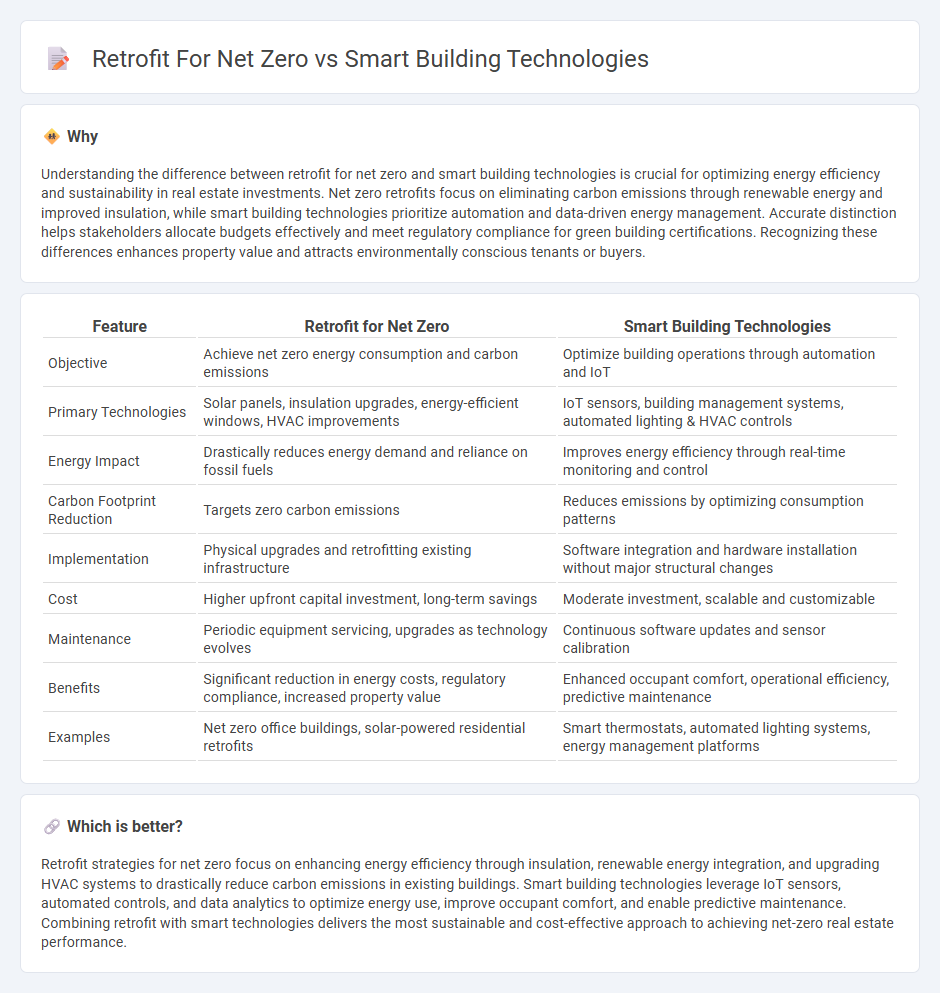
Retrofitting for net zero focuses on upgrading existing buildings with energy-efficient materials, renewable energy systems, and improved insulation to reduce carbon footprints and achieve zero net energy consumption. Smart building technologies utilize advanced sensors, automation, and data analytics to optimize energy use, enhance occupant comfort, and improve operational efficiency. Discover how integrating these approaches can transform real estate assets into sustainable and intelligent environments.
Why it is important
Understanding the difference between retrofit for net zero and smart building technologies is crucial for optimizing energy efficiency and sustainability in real estate investments. Net zero retrofits focus on eliminating carbon emissions through renewable energy and improved insulation, while smart building technologies prioritize automation and data-driven energy management. Accurate distinction helps stakeholders allocate budgets effectively and meet regulatory compliance for green building certifications. Recognizing these differences enhances property value and attracts environmentally conscious tenants or buyers.
Comparison Table
| Feature | Retrofit for Net Zero | Smart Building Technologies |
|---|---|---|
| Objective | Achieve net zero energy consumption and carbon emissions | Optimize building operations through automation and IoT |
| Primary Technologies | Solar panels, insulation upgrades, energy-efficient windows, HVAC improvements | IoT sensors, building management systems, automated lighting & HVAC controls |
| Energy Impact | Drastically reduces energy demand and reliance on fossil fuels | Improves energy efficiency through real-time monitoring and control |
| Carbon Footprint Reduction | Targets zero carbon emissions | Reduces emissions by optimizing consumption patterns |
| Implementation | Physical upgrades and retrofitting existing infrastructure | Software integration and hardware installation without major structural changes |
| Cost | Higher upfront capital investment, long-term savings | Moderate investment, scalable and customizable |
| Maintenance | Periodic equipment servicing, upgrades as technology evolves | Continuous software updates and sensor calibration |
| Benefits | Significant reduction in energy costs, regulatory compliance, increased property value | Enhanced occupant comfort, operational efficiency, predictive maintenance |
| Examples | Net zero office buildings, solar-powered residential retrofits | Smart thermostats, automated lighting systems, energy management platforms |
Which is better?
Retrofit strategies for net zero focus on enhancing energy efficiency through insulation, renewable energy integration, and upgrading HVAC systems to drastically reduce carbon emissions in existing buildings. Smart building technologies leverage IoT sensors, automated controls, and data analytics to optimize energy use, improve occupant comfort, and enable predictive maintenance. Combining retrofit with smart technologies delivers the most sustainable and cost-effective approach to achieving net-zero real estate performance.
Connection
Retrofit projects aiming for net zero energy integrate smart building technologies to optimize energy consumption and enhance operational efficiency. Advanced sensors, automation systems, and real-time data analytics enable precise control of heating, ventilation, lighting, and renewable energy sources within retrofitted structures. This synergy reduces carbon footprints while improving occupant comfort and driving sustainable real estate development.
Key Terms
Building Management Systems (BMS)
Smart building technologies enhance energy efficiency and occupant comfort by integrating advanced Building Management Systems (BMS) that utilize IoT sensors, real-time data analytics, and AI-driven automation to optimize HVAC, lighting, and energy consumption. Retrofit BMS solutions focus on upgrading existing infrastructure with modular, scalable controls to achieve net-zero goals without complete system overhauls, offering cost-effective pathways to decarbonization. Explore the latest innovations in BMS to unlock net-zero potential for both new and existing buildings.
Energy Efficiency Upgrades
Smart building technologies enhance energy efficiency by integrating IoT sensors, automated lighting, HVAC controls, and real-time energy monitoring, reducing consumption by up to 30%. Retrofit solutions improve existing infrastructure through insulation, window upgrades, and energy-efficient appliances, often yielding immediate energy savings and lowering carbon footprints. Explore detailed comparisons and optimal strategies to achieve net-zero goals effectively.
IoT Sensors
Smart building technologies leverage IoT sensors to monitor and optimize energy consumption in real-time, significantly reducing carbon footprints and operational costs. Retrofit solutions enhance existing structures by integrating IoT sensors that enable energy-efficient upgrades without the need for major construction, making them ideal for achieving net zero goals in older buildings. Explore how IoT-driven smart systems and retrofit strategies can transform your property into a net zero powerhouse.
Source and External Links
Smart Building Facilities Management Explained - This article discusses key smart building technologies, including IoT sensors, CMMS, BMS/BAS, AI, smart HVAC & lighting systems, and data analytics.
Smart Buildings | Technology Trends and Innovations - This webpage explores smart building technologies using IoT, machine learning, and automation to optimize performance, enhance user experience, and reduce costs.
What is a Smart Building? Technology Solutions & Examples - This guide covers smart building technology, including IoT automation, sensors for data collection, and analytics to manage energy and resources efficiently.
 dowidth.com
dowidth.com